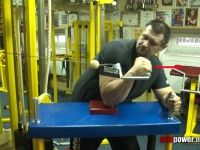Sets of Exercises for the Beginners
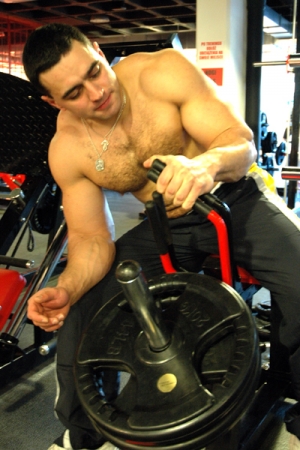 In this section you will find all exercises that must be present in an arsenal or every beginner. Each exercise will get a number that will ensure fast and correct planning of exercises and give a possibility to plan training for each arm-wrestler. These exercises can be performed on the simplest equipment available in any sportive club. From the list of these exercises everyone will be able to choose during the initial year such number of exercises and method of their performance in order to increase arm power potential and move from the category of beginners to the medium training level within the maximally short term. Arm-wrestlers use different methods of muscle strength development: dynamic (overcoming), isometric (holding) and plyometric (relinquent). Besides, once every two weeks it is reasonable to perform maximum weight lifts, i.e. to come to the limit. A beginner who does not make muscles work with maximal load in competitive mode in the process of training will not be able to do this during the competition in stressful conditions.
In this section you will find all exercises that must be present in an arsenal or every beginner. Each exercise will get a number that will ensure fast and correct planning of exercises and give a possibility to plan training for each arm-wrestler. These exercises can be performed on the simplest equipment available in any sportive club. From the list of these exercises everyone will be able to choose during the initial year such number of exercises and method of their performance in order to increase arm power potential and move from the category of beginners to the medium training level within the maximally short term. Arm-wrestlers use different methods of muscle strength development: dynamic (overcoming), isometric (holding) and plyometric (relinquent). Besides, once every two weeks it is reasonable to perform maximum weight lifts, i.e. to come to the limit. A beginner who does not make muscles work with maximal load in competitive mode in the process of training will not be able to do this during the competition in stressful conditions.
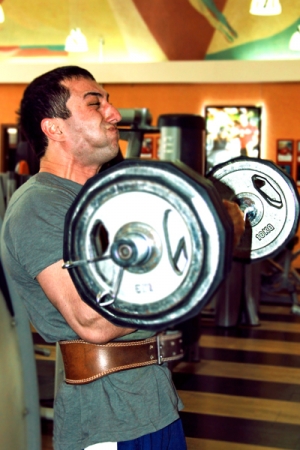 Three Methods of Muscle Strength Development:
Three Methods of Muscle Strength Development:
1.Dynamic (overcoming) or concentric method. Performing of arm/arms movement or body part from full amplitude with the use of weight or without it (pull-up on horizontal bar). This method is the basic one for relative power building and is also necessary for preparation of muscles to heavier loads. As a rule, power potential of concentric method enables developing strength for no more than 55-70% from total capacity of your organism.
2. Isometric (holding) or static method. It gives possibility to develop power in the certain WA (working angles). Movement is practically not observed in this method. Until recently it was considered the main method of arm-wrestler’s power development and it was used in all arm-wrestling schools. Main disadvantages of this method: fast organism fatigue leading toorganism overtraining, gaining power potential in the certain angles, increased risk of injury. Isometric method enables developing strength for no more than 70-90% from total capacity of your organism.
3. Plyometric (relinquent) or eccentric method. Gives possibility to develop maximal arm wrestler’s strength and is also the most innovative method in our sportive discipline. In distinction from concentric method, movement of arm/arms or body parts is performed backwards. Muscle shrinking is called eccentric if it occurs under the influence of exterior load with length increase. Popular belief ‘no pain, no gain’ is perhaps the most true concerning PE (plyometric exercises). Work is called relinquent if in its course muscle strength yields to gravity action of a body (limb) and the weight held by it. A muscle works but it does not shrink at this but, vice versa, lengthens, for example, when it is impossible to lift or to hold by weight a heavy object. When the muscle has made a big effort you will have to let this object down on the floor or onto another surface. Main disadvantage of this method is muscle fiber damage leading to painful feelings ending after 2-3 day interval. As a rule, this method is not for suitable beginners but you will use it in the future. Plyometric method enables developing strength in separate links of your arm and body parts for no more than 90-100% from total capacity of your organism.
A Few Valuable Instructions
- Before doing any exercise you must warm-up the certain muscle group thoroughly;
- Number of reps in the first set of each exercise shall be no less than 20-25;
- Selection of weights shall be done strictly individually;
- Make sure that set is performed with the right technique and with maximum weight;
- Do not start program if you did not recover after the previous training;
- Shall you feel any pain in muscle part being trained during the training you have to stop doing this exercise immediately.
Exercises for arms:
1. Dumbbell biceps curl with under-grip
Initial position: elbow with rest on hip interior, exercise is performed from the straighten arm position with dumbbell under-grip (see picture).
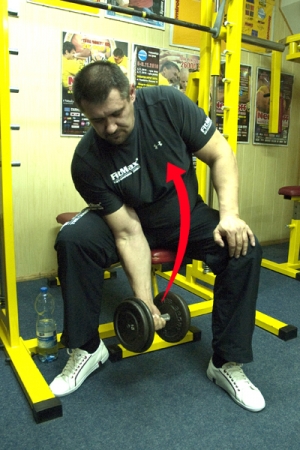
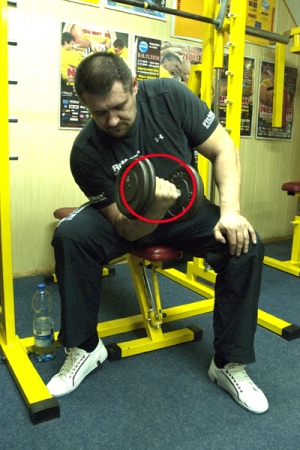
The same exercise can be done in three different methods:
a) dynamic (overcoming),
b) isometric (holding),
c) plyometric (relinquent).
Number of sets in option
а) from 4 to 6 and reps from 25 to 8. In option
b) no more than 3-4 sets, dumbbell holding from 10 to 25 seconds. In option
c) no more than 4-5 sets, from 8 to 4 reps.
2. Dumbbell biceps curl with hammer grip
Initial position: elbow with rest on hip interior, exercise is performed from straighten arm with dumbbell hammer grip (see picture).
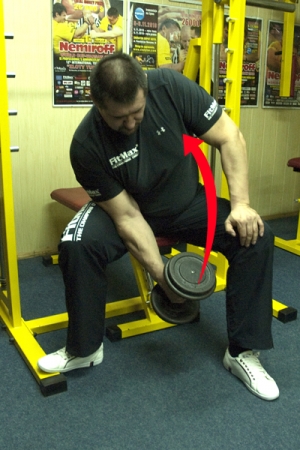
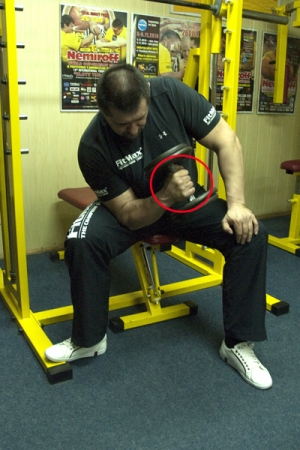
The same exercise can be done in three different methods:
а) dynamic (overcoming),
b) isometric (holding),
c) plyometric (relinquent).
Number of sets in variant
а) from 4 to 6 and reps from 25 to 8. In variant
b) no more than 2-3 sets, dumbbell hold from 10 to 25 seconds. In variant
c) no more than 3-4 sets, from 8 to 4 reps.
3. Dumbbell biceps curl with medium grip
Dumbbell curl with medium grip (grip between hammer and under-grip) elbow with rest on Scott Bench. Initial position: elbow with rest on Scott Bench, The exercise is performed from half-bent arm with medium dumbbell grip (see picture).
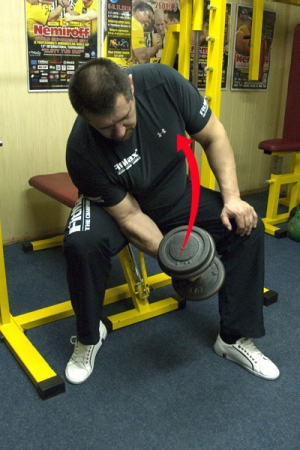
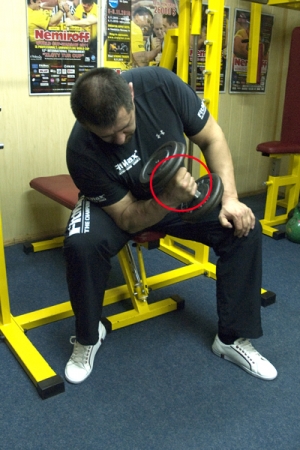
The same exercise can be done in three different methods:
а) dynamic (overcoming),
b) isometric (holding),
c) plyometric (relinquent).
Number of sets in variant
а): from 4 to 6 and reps from 25 to 8. In variant
b) no more than 2-3 sets, dumbbell hold from 10 to 25 seconds. In variant
c) no more than 3-4 sets, from 8 to 4 reps.
4. Dumbbell wrist curl with under-grip
Dumbbell curl on hand (thin neck), forearm parallel to floor. Initial position: forearm is on plain bench parallel to floor. The exercise is performed from unbend hand with dumbbell under-grip from below (see picture).
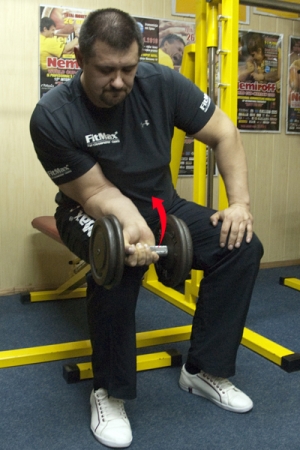

The same exercise can be done in three different methods:
а) dynamic (overcoming),
b) isometric (holding),
c) plyometric (relinquent).
Number of sets in variant
а): from 5 to 6 and reps from 20 to 6. In variant
b) no more than 3-4 sets, dumbbell hold from 10 to 25 seconds. In variant
c) no more than 3-4 sets, from 6 to 4 reps.
5. Weight wrist curl with hammer grip
Initial position: forearm is on plain bench parallel to floor, The exercise is performed from unbend hand with dumbbell hammer grip (see picture).
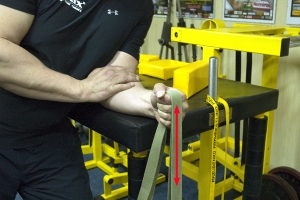

The same exercise can be done in three different methods:
а) dynamic (overcoming),
b) isometric (holding),
c) plyometric (relinquent).
Number of sets in variant
а): from 5 to 6 and reps from 20 to 6. In variant
b) no more than 3-4 sets, dumbbell hold from 10 to 25 seconds. In variant
c) no more than 3-4 sets, from 6 to 4 reps.
6. Pronator with load
Initial position: standing position, legs shoulder-width apart, perform twisting action of hand inside by the help of judo belt with loads fixed on it (see picture).
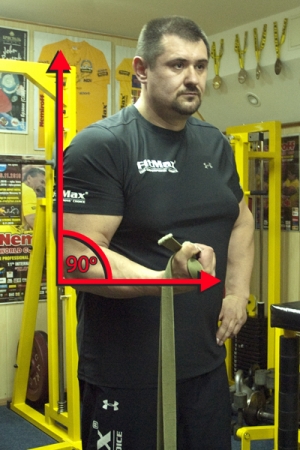
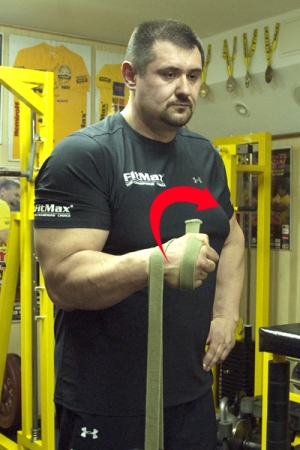
Angle in elbow joint is no more than 90º. The exercise is performed only in dynamic (overcoming) mode.
Number of sets in the exercise: from 4 to 6 and reps from 12 to 8.
7. Supinator with load
Initial position: standing position, legs shoulder-width apart, perform twisting action of hand outside by the help of judo belt with loads fixed on it (see picture).

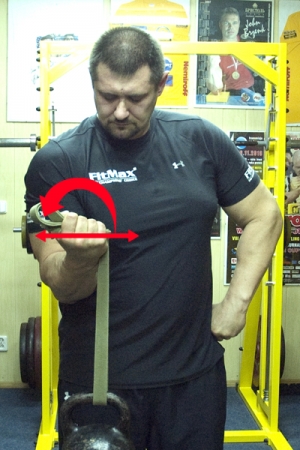
Angle in elbow joint is from 70º to 90º. The exercise is performed only in dynamic (overcoming) mode.
Number of sets in the exercise: from 4 to 6 and reps from 15 to 10
Exercises for muscles of back and arm muscles:
8. Pull-ups with under-grip.
Pull-ups with under-grip, narrow grip (see picture).
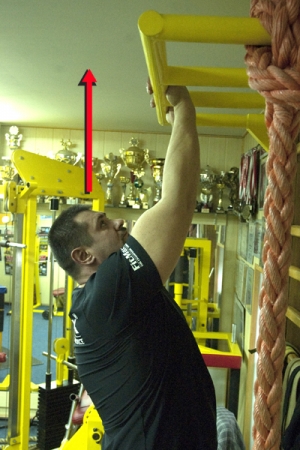
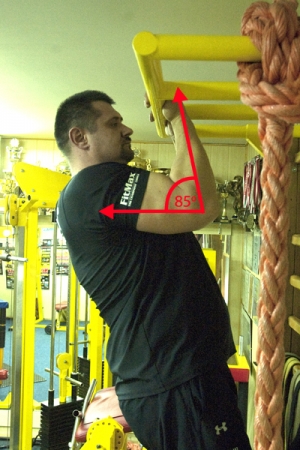
а) Perform pull-ups from straight hands.
b) Perform pull-ups from bent hands. (no more than 90º),
с) Stay on horizontal bar on bent hands (no more than 90º).
The exercise is performed in dynamic (overcoming) and isometric (holding) modes. In variant of performing this exercise in dynamic mode, number of sets: from 4 to 5 and reps from 15 to 8. In isometric (holding) mode: no more than 10-15 seconds. If in each mode it is easy for you to perform this exercise, in your further trainings we advise you to use load fixed on belt in such way as to perform instruction in this mode without exceeding the stated number of reps (dynamics) or number of seconds (isometry).
9. Pulling load to belt while leaning forward.
Initial position: lean forward, load/dumbbell in right or left hand. Pull load to belt (see picture).
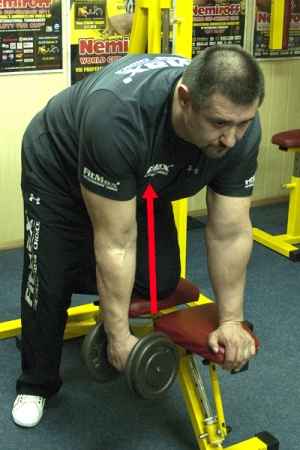
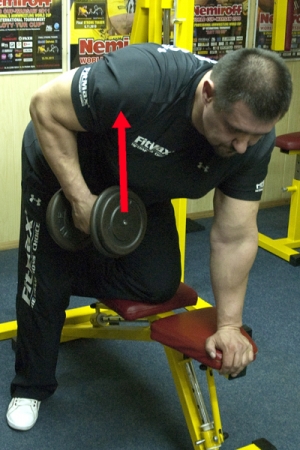
The exercise is performed in dynamic (overcoming) mode.
Number of sets in the exercise: from 4 to 6 and reps from 12 to 6.
10. Contraction on block with thick handle fixed on upper block
Initial position: sitting on bench, pull the handle from a cable machine towards you (see picture).
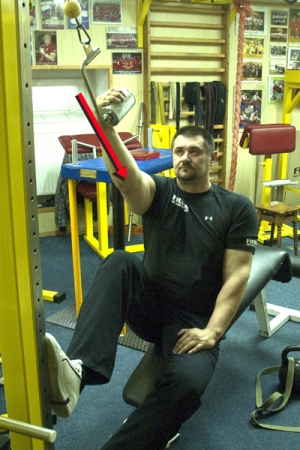
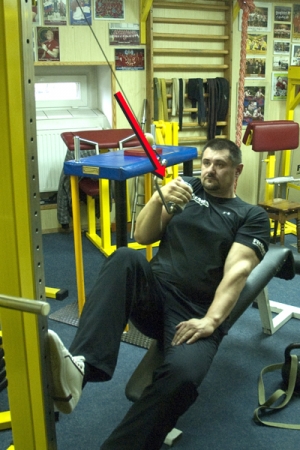
The exercise is performed in dynamic (overcoming) mode.
Number of sets in the exercise: from 4 to 6 and reps from 12 to 6.
Exercises for chest muscles and elbow ligament muscles:
11. Flat dumbbell flies
Initial position: lying on horizontal bench, flat dumbbell flies aside (see picture).
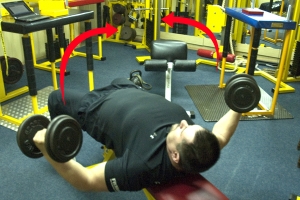
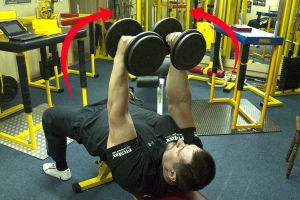
The exercise is performed only in dynamic (overcoming) mode.
Number of sets in the exercise: from 4 to 6 and reps from 10 to 8.
12. Parallel bar/parallel half-bar press
Initial position: parallel bar/parallel half-bar press. The exercise is performed only in dynamic (overcoming) mode (see picture).

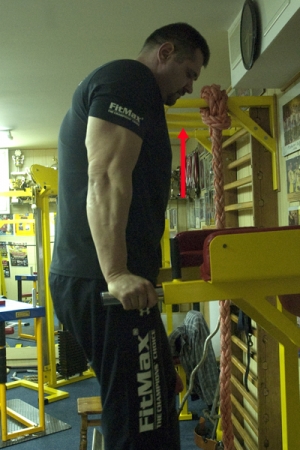
Number of sets: from 4 to 6 and reps from 10 to 4.
If it is easy for you to perform this exercise, in your further trainings we advise you to use load fixed on belt in such way as to perform instruction in this mode without exceeding the stated number of reps.
13. "Frontal pressure"
"Frontal pressure" or side pressure by the help of handle attached to the cable machine (see picture).
Initial position: elbow is on table pillow, handle and cable from a machine are parallel to floor.
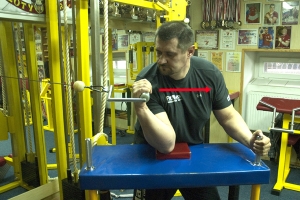

The same exercise can be done in three different methods:
а) dynamic (overcoming),
b) isometric (holding),
c) plyometric (relinquent).
Number of sets in variant
а): from 5 to 6 and reps from 20 to 6. In variant
b) no more than 3-4 sets, dumbbell hold from 10 to 25 seconds. In variant
c) no more than 2-3 sets, from 6 to 4 reps.
Follow the correct way of performance. ATTENTION during the performance of this exercise you can feel light pain in elbow ligament. When the pain occurrence repeats you must immediately stop performing this exercise until the full recovery.
Training Program
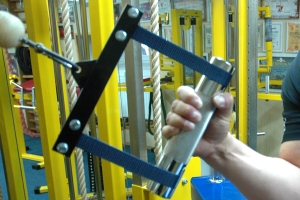 Here is the training plan for the beginners in arm-wrestling, which has been developed on the basis of multi-joint exercises. By performing this set of exercises you will be able to increase your power factors by adapting WA (working angles) to loads that are close to armwrestling.
Here is the training plan for the beginners in arm-wrestling, which has been developed on the basis of multi-joint exercises. By performing this set of exercises you will be able to increase your power factors by adapting WA (working angles) to loads that are close to armwrestling.
You should perform this plan during 2-3 months. If your arms strengthen you can move to more difficult variant of trainings. Weights and load shall be recorded in diary both in percent and in kilograms.
Conditioning/intermediate set of exercises for beginners in armwrestling.
This set of exercises is performed by beginners during 3-4 months. It is important to do control exercises before and after training cycle in order to define the increase of your power factor result.
Monday, Wednesday, Friday:
Monday.
1. Dumbbell biceps curl with under-grip, elbow resting on Scott Bench.
6 sets 15-15-10-8-6-6 reps each, weight 30% 30% 60% 70% 75% 75%
first two sets to be performed in full amplitude. After a thorough warm-up, perform the following reps from right angle upwards with working amplitude of no more than 30 degrees.
2. Dumbbell biceps curl with hammer grip, elbow resting on Scott Bench.
5 sets 15-15-10-8-6- reps each, weight 30% 30% 60% 70% 75%
first two sets to be performed in full amplitude. After a thorough warm-up, perform the following reps from right angle upwards with working amplitude of no more than 30 degrees.
3. Dumbbell wrist curl (thin neck), forearm parallel to floor.
5 sets 20-20-12-10-6 reps each, weight 40% 40% 60% 70% 80% first two sets to be performed in full amplitude, perform the following reps from right angle upwards with working amplitude of no more than 20-25 degrees.
4. Dumbbell wrist curl with hammer grip.
4 sets 15-15-12-10-8 reps each, weight 40% 40% 60% 70% 80% perform the exercise in full amplitude in all sets.
5. Flat dumbbell flies.
4 sets 15-12-10-10 reps each, weight 45% 50% 55% 60% exercise is performed on half-bent arms.
6. Parallel bar/parallel half-bar press.
4 sets 15-12-10-10 reps each with or without load depending on training level.
7. Pulling load to belt from bows front.
5 sets 12-10-10-8-6 reps each, weight 45% 55% 55% 60% 70% exercise is performed in full amplitude with staying in upper position.
8. ‘Frontal pressure’. Side pressure with handle fixed on block unit.
5 sets 15-12-10-8-8 reps each, weight 45% 50% 55% 60% 60% elbow is on table pillow. Be careful in performing this exercise because it has the highest risk of injury.
Set of exercises for beginners in armwrestling
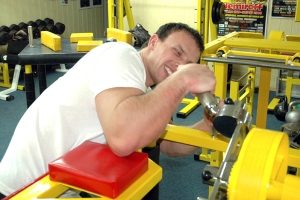 This set of exercises is the next stage of beginners’ training and includes elements of general physical training and specialized exercises. We advise you to perform this set for 2-3 months; do control exercises before and after training cycle.
This set of exercises is the next stage of beginners’ training and includes elements of general physical training and specialized exercises. We advise you to perform this set for 2-3 months; do control exercises before and after training cycle.
Monday, Wednesday, Friday:
Monday
1. Dumbbell wrist curl (with thin neck), forearm parallel to floor
6 sets 20-20-12-10-6-4 reps each, weight 40% 40% 60% 70% 80% 90% first two sets are performed in full amplitude and the next ones from straight hand upwards with amplitude of no more than 20-25 degrees.
2. Dumbbell biceps curl with medium grip (grip between hammer and under-grip) elbow with rest on Scott Bench
6 sets 15-15-10-8-6-4 reps each, weight 30% 30% 60% 70% 80% 90%
first two sets are performed in full amplitude as in the previous exercise. After a thorough warm-up, perform the following reps from right angle upwards with working amplitude of no more than 30 degrees.
3. "Frontal pressure" with handle attached to the cable machine
5 sets 15-12-10-8-6 reps each, weight 45% 55% 65% 75% 85% perform this movement smoothly and without snatches, working angle in elbow is no more than 80 degrees, elbow with rest on table pillow.
4. Pronator with judo belt strap angled from lower part of the cable machine
6 sets 15- 15-12-10-8-6 reps each, weight 40% 40% 50% 60% 65% 70%
5. Supinator with judo belt strap angled from a top part of the cable machine
6 sets 15- 15-12-10-8-8 reps each, weight 40% 40% 50% 60% 65% 65%
6. Contraction with thick handle angled from a top part of the cable machine
5 sets 15-12-10-8-6 reps each, weight 45% 55% 65% 75% 85%
Wednesday:
Perform the same training plan but decrease working load by 10%-15% and increase number of reps in the first set to 20. Be careful and don’t let any painful feelings occur in the course of your training.
Friday:
Perform Monday scheme with regard of weight in percent ratio.
In 3-4 weeks do control exercises with maximal weight. It is not necessary to do control exercises in all exercises. First try them on 2, then on the next 2. Don’t forget that quality shall prevail over quantity.
Igor Mazurenko

